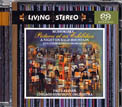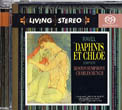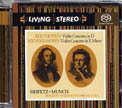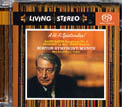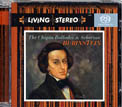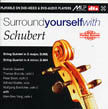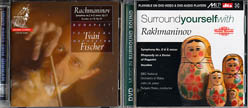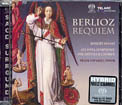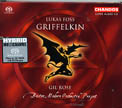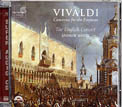|
You are reading the older HTML site
Positive Feedback ISSUE
15
Hi-Res reviews featuring our friends from Audiophile Audition 39 SACD & DVD-A Reviews - October 2004, Part 2 of 3 - Classical
The two big events in hi-res disc'ing this time are the first of the RCA "Golden Age" Living Stereo masters in SACD and the first of the Nimbus Ambisonic masters in DVD-A and DTS. So we'll start off with some of both and have even more next issue. The original LPs of RCA's acclaimed Living Stereo series - with such top flight artists are Charles Munch, Fritz Reiner, Van Cliburn, Pierre Monteux and others—are considered such perfect marriages of successful minimalist recording techniques and masterful performances that if in mint condition have claimed collectors' prices of over $1000 for a single LP. Many titles from the series—usually covering a period from the mid-fifties (when stereo recording began) to about 1964 or so (when the advent of the transistor, multi-tracking and multi-mic'ing, and gimmicks such as DynaGroove impinged on the high quality)—have been reissued in many different forms. Some were available on open-reel tape at one time. The standard CD reissue of most of the Living Stereo titles was the most successful classical reissue series in that format. It boasted both good transfers to the CD medium and combinations in most cases on a single CD of material previously been released on two LPs. The Classic Records vinyl reissues have brought the Living Stereo library to many analog-conscious audiophiles, with both 33 and 45 rpm versions of many of the albums. Just recently JVC has been reissuing some of the Living Stereo titles in their higher-resolution format, but offering only the same program lengths as the original LP releases. About a year ago Harry Pearson in TAS was imagining (after hearing the first 3-channel SACD reissue, from Everest) how great it would be if both the Living Stereo and Mercury Living Presence 3-channel masters were reissued on SACD. Now it is happening: the first ten titles of the new SACD Living Stereo series have been released by BMG (on 9/14/04) and many of them are 3-channel. They follow the same programming as did the standard CD reissues, and with the great transparency of DSD re-mastering we are brought closer to the original master tapes than ever before. (I am looking forward to receipt of the same title as the Living Stereo releases I happen to have on Classic 45 rpm for comparison—since that was the best fidelity from the series I had yet heard.) The engineering staff, led by John Newton, employed the latest highly-tweaked professional solid state open reel decks on which to play the masters (many of which are at a higher-fidelity 30ips instead of the standard 15ips). He feels that the modern analog transports allowed the hearing of material on the tapes that did not come through on the original tube-type Ampex analog tape recorders. He used modded Studer A80 open reel analog decks with special playback heads from Flux Magnetic designed to minimized flutter and wow. The five-channel Aria Class A amp was used instead of the Studer electronics. (The current Silverline reissue of the Vanguard Utah Symphony tapes also used them.) dCS designed custom analog-to-DSD converters for the project. Not wanting to gild the lily of the highly-regarded Living Stereo sound quality, no signal processing or equalization was used to "improve" the sound of the originals, although the Aria has provision for that. Most of the RCA tapes also used a sort of primitive precursor of Dolby A noise reduction called an AME box to reduce hiss. The note booklet with all of the discs has a section on the History of Living Stereo. It opens with a confusing statement requiring clarification. It describes RCA's first experimental "binaural" recordings of October 1953 at Manhattan Center. True, the word is in quote marks, but it is still incorrect. Binaural recording was a different process entirely, using two channels but requiring a dummy head with microphones in the ears, and designed for headphone playback, not on loudspeakers. Two-channel stereo is strictly for speakers and is actually inappropriate for headphone playback. [For more information Go Here.] Emory Cook and others mis-used the term binaural to refer to stereophonic and thereby caused endless confusion in the public mind. Probably the most interesting thing about the new BMG SACD series is that many of the original masters—as was true of many early professional stereo recordings on tape—were not recorded two channels but three. During the 1950s three-channel professional recorders were used more than two-channel models. Mercury Living Presence, Columbia, Vanguard and Everest also used this approach. After all, the stereodisc—with its limitation to just two channels—had not yet been introduced, and when Alan Blumlein invented stereo in the early 30s he envisioned it as at least three channels. The general idea was that when stereo became a consumer format it would be three channel. For two-channel stereo release the center channel signal was mixed equally into the left and right channels using a simple summing circuit. BMG has decided (as has Universal for the Mercury SACDs) that they will not re-mix the original three channels for 5.1 surround but furnish them exactly as they were recorded—as the "multichannel" option on the hybrid SACDs. The SACD Stereo option is a similar stereo mix to that heard on the CD reissues. The jewel boxes do state on the back that music will not be heard from the surround channels, and also identifies those discs in which some of the selections are 3-channel while others are normal 2-channel. (This should prevent the confusion I had when auditioning that first 3-channel SACD from Everest—which said "multichannel" but had no surround signals, leading me to think I had a bad connection or had blown something.) If you have an identical or fairly well-matched speaker for your center channel you will probably be amazed at the improvement in the frontal soundstage on many of these SACDs with three discrete front channels instead of a phantom center. These is more depth, width and improved spatial placement of the various sections of the orchestra and individual soloists. I was just wishing BMG had given us a bit of derived L-R ambience on the surround channels which could be turned off or on. Or else that my AV preamp allowed implementing Dolby Pro Logic II for the surrounds only while feeding the unadulterated signals to the front three channels—but it doesn't. Most listeners won't begin to miss the surrounds since the frontal soundstage is so compelling and involving. It reminded me somewhat of the improvement realized with the 2+2+2 approach of D&G on their SACDs and DVD-As; they employ four speakers in front instead of three but the enlargement of the soundstage is very similar—especially if your center speaker is mounted higher than your left and right speakers, as is mine.
RAVEL: Daphnis et Chloe (complete) - New England Conservatory Chorus & Alumni Chorus/Boston Symphony Orch./Charles Munch - RCA Living Stereo SACD 82876-61388-2, 54:29 - 5 stars The sensuous appeal of this version of the wonderfully evocative and very French ballet score has probably never been surpassed. In fact, I would call this the very best of the half dozen or so Living Stereo SACDs I have heard so far. John Pfeiffer produced it in l955, well before the introduction of the stereodisc. It was recorded two-channels only, but still easily beats out the LP and standard CD versions, and doesn't seem to suffer in comparison to the other Living Stereo three-channel SACDs. The original LP was quite an achievement since it runs nearly 55 minutes, and after about 40 minutes total things were getting dicey at maintaining good sound when mastering an LP. Comparisons were made of the SACD, a recent xrcd reissue and the Classic Records LP. I found it surprising that the general timbre and balance of the LP and SACD were almost identical. Even the hiss level was the same if the volume was turned up considerably; of course on the LP it was accompanied by a few light surface noise artifacts as well, so there was no difficulty telling the two apart. About the only difference I could identify was a somewhat warmer and more silky sound of the massed strings on the vinyl. Previous differences of the digital version lacking "air" around the instruments vs. the vinyl version were not heard—the SACD is just as airy. The xrcd was quite hard and glassy-sounding, especially in the climaxes, and it lacked the super-wide dynamic range of the SACD. However, I note both in this SACD and most of the Living Stereo SACDs a slight tendency toward a hardness in the treble which I don't notice on SACDs from more recent masters. However, if you want to sample just one of the new Living Stereo SACDs, I would highly recommend this one; of course it also happens to be my favorite ballet score. (I once used the Dawn sequence as the Sign On music for a classical station I managed.) John Sunier
MUSSORGSKY: Pictures at an Exhibition; A Night on Bald Mountain; BORODIN: Polovtsian March; TCHAIKOVSKY: Marche miniature; Marche slave; KABALEVSKY: Colas Breugnon Overture; GLINKA: Russlan and Ludmilla Overture - Chicago Sym. Orch./Fritz Reiner - RCA Living Stereo 3-channel SACD 82876-61394-2, 70:57 - 4 stars Reiner's version of the warhorse has been the audiophile favorite for four decades now and has never sounded better fidelity-wise. It may not be identical to listening to the master tapes but it certainly is closer than we have ever come previously. It may not be the last word in interpretation of the work either, but it beats out the competition in the sound department in this new reissue. Comparison of the three options on the disc were interesting: The standard CD layer was passable but typically opaque and with a flat soundstage perspective. The two-channel stereo SACD layer brought out more richness, depth and detail and the soundstage took on a natural breadth across the front of the listening room. Going to the three-channel option made a major improvement in depth, spatiality of all the orchestral elements, and in general impact. It also sounded just about as good when sitting at either end of my sofa, whereas the realism of the two-channel SACD was compromised when I moved out of my sweet spot. John Sunier
BEETHOVEN: Violin Concerto in D; MENDELSSOHN: Violin Concerto in E Minor - Jascha Heifetz/Boston Sym. Orch./Charles Munch - RCA Living Stereo SACD, B=2-channel; M=3-channel - 82876-61391-2, 62:05 - 4 stars An interesting comparison of two and three-channel reproduction. The Beethoven was taped in l955 in two channel. Heifetz didn't feel he was spotlit well enough in that recording and asked that when he recorded the Mendelssohn in 1959 it be done three channel. Producers and recording engineers should pay less attention to such demands of performers; even Stokowski has some dumb ideas about achieving the best sound. The Beethoven sounds much better - the violin is integrated into the music even though it is unnaturally spotlit aurally, just as are the solo instruments in most commercial concerto recordings. The phantom violin at center is just fine, thank you. In the Mendelssohn Heifetz doesn't sound any louder in relation to the orchestra, but he sounds like he was recorded in a different location entirely—the way many pop vocalists are done. He is separated from the orchestra in an artificial manner. The Mendelssohn was issued recently on an xrcd. Heifetz tone, which is silky and sweet on the SACD, is hard-edged and teeth-rattling on the xrcd—a clear case of string digititus. The three-channel SACD has a wider, deeper and more spatial display of the orchestra than the xrcd, but the necessary phantom center channel for the violin sounds better than the discrete center on the SACD. Also, it puts Heifetz at a normal height on the soundstage rather than elevated—since my center channel speaker (though identical to the L & R) is atop my RPTV rather than in line with the L & R speakers. (I need hardly point out that these SACDs all incorporate what was issued on two separate LPs originally, whereas the xrcd reissues merely duplicate the LP program, even if less than 30 minutes length. The SRP we're looking at here would be a total of $60 vs. $11.) John Sunier
SAINT-SAENS: Symphony No. 3 ("Organ"); DEBUSSY: La Mer; IBERT: Escales - Boston Sym. Orch./Charles Munch (Berj Zamkochian, organ) - RCA Living Stereo 3-channel SACD 82876-71387-2, 73:04 - 4 stars Another audiophile blockbuster which versions coming out since this 1956 taping have been hard-pressed to top. Not one of the greatest symphonies ever written but lots of fun if you can be patient until the final movement—which is where all the action occurs. This collection from two original Living Stereo LPs showcases the great affinity the BSO under Munch showed for the French repertory. Toscanini and Bernstein might be more dramatic in their versions of Debussy's impression of the varying moods of the sea, but Munch brings out an almost pictorial interpretation of the play of the waves, and in three-channel sound it really envelopes the listener. A recent xrcd of the Organ Symphony was out-distanced again by the SACD, although it did prove an improvement over the standard CD in frequency range, clarity and less congested climaxes. The SACD provided about the same enhancement over the xrcd in clarity, impact, a wider and deeper soundstage and better placement spatially of the various sections and instruments. In the exchanges between the piano on the left channel and the organ the piano sounded more like a real piano on the SACD. The big finale's climaxes were also much cleaner, although still a bit hard-edged as mentioned before. When an instrument has a solo stint in the center of the orchestra it is more realistic and palpable, yet doesn't sound oversized. John Sunier
BARTOK: Concerto for Orchestra; Music for Strings, Percussion and Celesta; Hungarian Sketches - Chicago Sym. Orch./Fritz Reiner - RCA Living Stereo 2 and 3-channel SACD 82876-61390-2, 76:07 - 4 stars Just as Munch was tops with the French repertory, so Reiner shown brightly in these three Hungarian works by his most famous composing countryman. The earlier-recorded Concerto of 1955 is two channel and the later two works are three. In this case I also had the Classic Records LP plus the JVC xrcd reissue. Again, the SACD and LP were extremely similar. Although the xrcd was an improvement over the standard CD, the strings at the beginning of the Music for Strings are muddled, flat and opaque, whereas on the SACD they are more distinct, separated and with a wider soundstage. The center of the orchestra also filled in better—both on the Concerto and on the other works using the three-channel approach. Each step up reduced the digititus hardness in the strings, with the LP boasting perhaps the last word in string silkiness. Of course this would also be dependent on the quality of your cartridge/arm/turntable/phono preamp source. John Sunier
CHOPIN: Ballades Nos. 1 - 4; Scherzos Nos. 1-4 - Arthur Rubinstein, piano - RCA Living Stereo 3-channel SACD 82876-61396-2, 71:24 - 4 stars The four Ballades are to my mind the most amazing works in the entire Chopin literature, and Rubinstein has long been regarded as one of their finest interpreters. The four works are the closest the composer came to writing programmatic works; they are easily recognized without any stretch as being narrative in nature - though we are left to sort of make up our own story that is being told. It is possible that they are based on specific poems by a Polish poet, but we don't know which poems. Rubinstein tells the stories with great drama and lightning changes of mood and tempi. He's not as note-perfect as heard in recordings released today but not terribly distracting in his few flubs; certainly nothing like Schnabel—who is too much for my ears, having been a piano major myself. I find most classical piano recordings to be mic'd too closely in general and therefore producing the acoustic picture of 40-foot-wide grand pianos on the soundstage. (This never occurs, by the way, in binaural recording.) That is exactly what the two-channel version as well as the stereo standard CD version sounds like on this disc. However, the three-channel SACD layer doesn't sound like the piano is too side—it just sounds like you are VERY close to the piano. Perhaps turning pages for the performer? John Sunier More Living Stereo SACDs next month... Next are the first batch of DVD-A releases from Nimbus Records... The UK label Nimbus Records has been recording with the Ambisonics surround system since 1972 and has a large library of masters recorded in surround, mostly classical but with some world music as well. Most of it was not recorded in the standard B-format Ambisonic form, which requires multiple channels, but in the matrixed-down two-channel form known as UHJ, for which special decoders are required. Ambisonics has never really been successful as a consumer format (although I personally find it far superior to the present 5.1 discrete channel format), but now that there are two consumer hi-res formats on offer (and Nimbus is back after bankruptcy) the label decided to begin release of their catalog on DVD-A discs. Being a bit of an iconoclast, Nimbus went about this a bit differently. Their goal was to bring SSfM to as large an audience as possible, so the first options on these discs is for DVD video-only players. There is a two-channel PCM option which is 48K/24bit and will play back on any DVD player. This option is the original Ambisonic UHJ-encoded signal, which is compatible for stereo playback if one lacks the decoder (and nearly everyone does). The only disadvantage here is that without decoding—even by just feeding the L - R signal to a single speaker in the back of the listening room—the sonic picture tends to be too "wet" and a bit too distant from the listener. This was a quality pointed out by most reviewers of previous Nimbus discs who didn't have the decoders. Also for most DVD players is the DTS surround option, which is four channel 48/24. Nimbus says over 90% of DVD homes are now equipped for DTS decoding—either in the player or preamp/receiver—so it was decided in order to accommodate the up to 90-minute playing length of these discs to eschew Dolby Digital encoding altogether. It was felt unnecessary to offer two compressed formats. They also found that maintaining proper phase relationships was very important in the conversion of the original Ambisonic recordings, and DTS was more reliable in this regard than Dolby Digital. Then to the DVD-A layer, which uses the MLP lossless codec at 88.2K/20bit for the highest fidelity four-channel layout. If you have a DVD-A player you will probably find that the disc automatically defaults to DVD-A and may not even allow you to sample the DTS option.
[Actual title: Surround Yourself With Elgar] ELGAR: Enigma Variations; Cockaigne Overture; Pomp and Circumstance Nos. 1 - 5; Froissart - English Sym. Orch./William Boughton - Nimbus Records DVD-A NI 9001, 88:30 - 4 stars A very appropriate first release in this series for a British label such as Nimbus! 88 minutes of the most unabashedly English orchestral music one could find, and played to a fare thee well. Only the Froissart tone poem is more redolent of the Germanic influence on British music. The Edwardian era comes to life in the other works, especially the familiar marches. The recordings date from the late 1980s and the orchestra sounds rich and full, and with much more presence in the DVD-A re-mix than in the original UHJ CD release of some of this music. The surround effect is strong without unnaturally sending instrumental sections around the listening room. The transparency and general surround field is just as effective as on the best multichannel SACDs. The visual element is not regarded as a strong focus on these discs, which are designed to be played without requiring a video display at all. The screen image you get if you do choose a display with the DVD-A is merely a title slide with the name of the particular movement of the work, which disappears from the screen after about ten seconds. John Sunier
Actual title: Surround Yourself With Schubert FRANZ SCHUBERT: String Quintet in C Major D956; String Quartet in A Minor D804 - Brandis Quartet with Wen-Sinn Yang, cello - Nimbus Records DVD-A NI 9005, 90:06 - 4 stars The longer playing time possible on DVDs allows Nimbus to create some pairings that would not be possible on SACD—for example, this disc is a good ten minutes over the SACD length limit. The recordings date from 1993 to 1995 and were made in the studio of the country estate of Nimbus, located close to the border with Wales. This is not the first hi-res disc'ing of the great C Major Quintet I have auditioned but I believe this one jumps to the top of my list on first hearing. The Berlin-based quartet has a fine singing style which is perfect for Schubert, and they are cleanly spaced across the frontal soundstage. This may have been recorded in a studio but it is obviously not a typical small overly-damped studio—one senses the space in which the players are situated. I have a Cantares UHJ decoder but didn't have time as yet to audition and compare the Ambisonic PCM layer with the MLP and DTS, but will for future reviews. John Sunier
RACHMANINOFF: Symphony No. 2 in E Minor; Vocalise - Budapest Festival Orchestra/Ivan Fischer - Channel Classics multichannel SACD CCS SA 21604, 64:35 ****: Actual title: Surround Yourself With Rachmaninoff RACHMANINOFF: Symphony No. 2 in E Minor; Rhapsody on a theme of Paganini; Vocalise - John Lill, piano/BBC National Orchestra of Wales/Tadaaki Otaka - Nimbus Records DVD-A NI 9003, 89:38 - 3 1/2 stars: Little need to say much about these familiar works. The choice here is between surrounding yourself with 65 minutes of Rachmaninoff vs. 90 minutes. The Nimbus DVD-A boasts a closer perspective than the Channel Classics, which is a new thing for Nimbus since their former discs had complaints of being recorded too distantly. There is somewhat less of a soundfield with the Nimbus than the CC, although it is extremely transparent and detailed. The CC effort is their first with a major symphony orchestra in standard repertory, and although this orchestra may not be well known on the strength of this release it is clearly one of the most exciting in the world today. It sounds more finished and elegant than the Welsh orchestra, with more flowing phrasing in their interpretation of the symphony. The Hungarian musicians play with real passion. The CC disc gives us more of a feeling of the hall environment although the frontal soundstage is more distant. In the lovely Vocalise the Nimbus disc is more mellow while the Budapest players are heard with more clarity and high frequency energy. Of course the CC disc lacks the Paganini Rhapsody, and this is a very spectacular performance to be sure. But in this case—not due to any leaning toward one format or the other—I would vote for the Channel Classics version. John Sunier
BERLIOZ: Requiem (complete) - Frank Lopardo, tenor/Atlanta Symphony Orch. & Chorus/Robert Spano - Telarc multichannel SACD-60627, 77:40 - 3 stars For many years I lived with a fine four-channel quadraphonic tape iteration of this most famous work designed for spatial performance—Vanguard's open reel tapes of the Utah Symphony/Abravanel recording in the Mormon Tabernacle. The only bother was the setting up my four-channel deck and the hiss to be contended with (especially since one reel was on super thin 1-mil tape!). Not long after multichannel SACDs were introduced Vanguard released this exciting performance in 4.0 SACD. Unfortunately, something went wrong and the climaxes in it were seriously distorted. More recently, with ownership of the Vanguard masters in the hands of Artemis Recording, the Utah Requiem was reissued and done right this time. Now Telarc enters the competition with a brand new 5.0 surround recording of this amazing spatial liturgical work. The chorus sound is cleaner and more understandable than in the much earlier version and the orchestral detail is more pronounced. The tenor in the beautiful Sanctus movement is excellent, and Telarc chose to place him at the rear of the hall—an interesting additional spatial assignment. However, the performance lacks the alternating hellfire and heavenly excitement of the Utah version, as well as the voluminous acoustics of the huge Mormon Tabernacle. Even the entrance of the four brass choirs in the Dies Irae and Rex Tremendae sections has more heart-stopping impact on the Utah recording. So I believe I'll stay true to the early 70s version, which also is spread across two discs and gives you an excellent Mahler First Symphony as well. John Sunier
LUKAS FOSS: Griffelkin – Boston Modern Orchestra Project with vocal soloists and members of the Boston Children's Opera / Gil Rose, Director – Chandos CHSA 5009(2) – 2 Multichannel Hybrid SACDs – 102 minutes - 5 stars Back in the early days of network television, when the programmers were much more concerned with quality programming than reality shows, NBC came up with a novel idea: a live broadcast of an opera with family appeal, Menotti's "Amahl and the Night Visitors." The broadcast was a great success, and the network immediately commissioned Lukas Foss for another to follow on that success. The result was "Griffelkin," a work that had been germinating in Foss' mind since childhood and was based on the fable of Griffelkin, a young, coming-of-age devil who's sent to earth with a limited supply of magic dust with which to create mischief. He ends up using some of the dust for good, rather than evil, and is banished to the world of humans. Foss wanted to create an opera that would appeal to children from 8 to 80, and the work he presented seems to accomplish that goal in spades—there's something here for just about everyone. In keeping with the subject material, there's something very Halloweenish about the proceedings, but it suits the music very well. It's also refreshing to hear an opera sung in English for a change. The music in places is very much reminiscent of Stravinsky—rhythmically and harmonically it made me think often of Petrushka. The libretto flows very well with the scoring, and the vocalists all acquit themselves admirably. The scene with Griffelkin and the lions is particularly amusing and effective; however; there is much that is poignant and contemplative as well, such as the touching scene in Act III when the children's mother dies and is revived with the help of Griffelkin's magic dust. As much pleasure as I've gotten from listening to this disc, I'm certain that a live presentation of Griffelkin would be a delight for both adults and children to experience. The multichannel SACD is recorded in DSD—this may be a first for Chandos, and there has been some grumbling about their 24/96 transfers to SACD (I own all of the VW symphonies released so far, and all are excellent in my book). The recorded sound here shimmers and sparkles, and just leaps out of your system—this is what SACD should be all about! Very, very highly recommended. Tom Gibbs
VIVALDI: Concertos for the Emperor - No. 2 in C RV 189; No. 10 "L'amoroso" in E Major RV 271; No. 3 in c RV 202; No. 7 in C RV 183; No. 11 "Il favorito" in e RV 277; No. 4 in F RV 286 - The English Concert/Andrew Manze, solo violin & director - Harmonia Mundi multichannel SACD HMU 807332, 78:52 - 4 stars These works were commissioned by Charles VI, the Hapsburg ruler of a good part of Europe in the early 18th century. Vivaldi had earlier dedicated his famous La Cetra Opus 9 set of concertos to the emperor. This is not just another set of ho-hum Vivaldi concertos. There are plenty of differences between the half dozen works, and Manze points some of them up thru the use of different instrumentation. For example, in Concerto No. 11 he substitutes a guitar for the continuo part usually handled by the harpsichord. Manze recently became director of the famed authentic chamber ensemble which had been founded in l973 by Trevor Pinnock and is considered by many to be the best of its kind in early music. He exercised his musicological talents on these six works, reconstructing them from a spotty manuscript of 1728, and this is the first time them have been presented together. The ensemble has a delightfully spontaneous playing approach which combines the raw energy of groups such as Il Gardino Armonico with a higher degree of performing polish. Manze has been called the first superstar of the Baroque violin since the Baroque period. The recording was made at London's Air Studios and the surround field, while used with discretion, adds to the realism of the ensemble on the frontal soundstage. It is 5.0 (almost all of the classical labels agree the LFE channel is superfluous for music) and there is quite a bit more signal on the center channel than on most of the SACDs from Telarc and Universal. John Sunier Reviews reprinted with permission from Audiophile Audition
|


